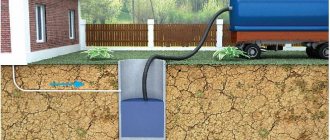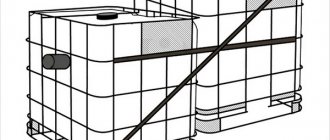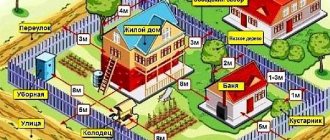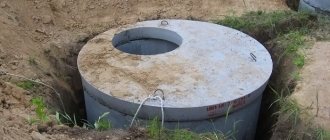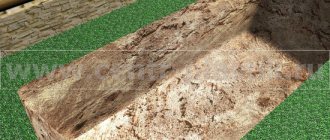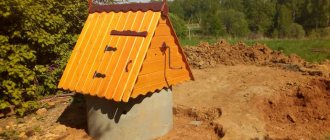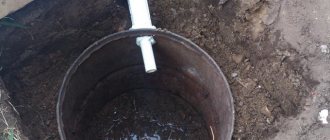Today you can easily purchase a ready-made industrial septic tank or build capital treatment plants yourself. But if you need to organize temporary sewerage or the volume of wastewater in a country house is small, you can use simpler and more affordable solutions. For example, build a septic tank from plastic barrels with your own hands. Such a treatment plant will help make life more comfortable and at the same time cope well with the wastewater treatment tasks assigned to it.
Building a house is quite a long process. In order not to give up your usual amenities during construction, you can build a temporary local sewer system - a homemade septic tank. It can be assembled from two 200 liter plastic barrels.
To build such an installation, you can use old, but leak-free plastic barrels. The use of metal barrels is impractical, since the metal is quickly destroyed by sewage. An installation made from metal barrels will not last long.
A septic tank made from barrels is a simple installation, but it is still more convenient than a cesspool or storage tank. Such a septic tank purifies rather than heats the water, so the need for pumping occurs less frequently.
What are the advantages of making your own design?
If there is no centralized water supply and sewerage network near the site, there is a need to build an autonomous system. A self-made septic tank from barrels disposes of wastewater in accordance with hygienic standards.
The design is designed to withstand a certain volume of sewage, taking into account the people living in the house. Installation of a homemade device is recommended for the following reasons:
- Reduced costs.
- Independent purchase of components + use of existing materials.
- Use of available tools.
- The equipment is installed according to a modular scheme, that is, the possibility of additional equipment is calculated in advance - connecting additional drain pipes to reserved entry points.
Only a person who has built his own drainage system understands the weaknesses of the design and knows its maximum capabilities. By calculating the approximate norms of water consumption of a family, the frequency of residence and, having studied the features of the land plot, you can avoid unnecessary financial costs, physical losses, and prevent “emergency situations” caused by low capacity.
On a note! The principle of operation of a cesspool made from barrels is the construction of multi-level settling tanks, as a result of which overflowing, waste settles and the separation of wastewater into water and sludge is ensured.
After the process is completed, about 65% of the water is discharged into the ground, and sediment accumulates at the bottom until it is pumped out of the treatment plant.
Will this volume of septic tank be enough?
If you use it fully (shower, toilet, sink, etc.), then the calculation is based on 200 liters per person per day. If there is only a toilet, then 25 liters per person per day. The septic tank must have at least 3 daily water consumption.
However (from the photographs), it turns out that the second barrel chamber “works” only at half the volume (about 100 liters), and the third, in general, at a quarter. In total, the total volume of the septic tank is 200+100+50 = 350 liters... It seems to me that this is really not enough for peace of mind).
It turns out that there are about 150 liters in one barrel * 3 = 450. According to my calculations, this is enough for three (only the toilet is hooked up).
I have an analogue. Three children and two adults year-round. Works for 1 year and 10 months. Haven’t pumped it out yet. In addition, there is a 10 meter leaky pipe in the ground.
What are the pros and cons of plastic and metal barrels
The basis for the construction of an autonomous sewer system is a tank-barrel. For arrangement, two types are used - metal or plastic. Since making a septic tank from barrels with your own hands is not so easy, the choice of container is up to the owner. Metal containers usually have a capacity of 200 liters. Plastic - available in large sizes. Based on economic considerations, it is better to install existing containers. But when you plan to buy containers, you should explore different options.
Plastic version
Pros of use:
- Little weight;
- Ease of installation;
- Ease of making holes;
- Completely waterproof;
- Corrosion resistance.
Disadvantages of products:
- The low weight of the product requires stable attachment to the foundation to avoid “floating” when flooded due to excessive rainfall;
- The elasticity of the material leads to compression of the containers by soil.
Iron version
Advantages of iron barrels for the construction of a cesspool:
- High rigidity and strength of products;
- Sufficient water resistance;
- Stability of the structure.
Flaws:
- Susceptibility to corrosion, which requires the application of a waterproofing coating;
- The labor-intensive process of making holes using power tools.
The main disadvantage of a barrel sump is the small volume of the chambers. This is the reason for the frequent pumping of sludge.
Please note! If the volume of the chambers corresponds to barrels with a capacity of 200/250 liters, the discharge of wastewater must be regulated.
Choice of material: metal or plastic
In order to save money, very often a septic tank in a country house is made from barrels that previously served another function. For example, they could be used to store grain, sand, cement and other bulk substances. The container can be metal or plastic, the main thing is its tightness.
If the question of purchasing a barrel still arises, then it is better to give preference to plastic. And that's why:
- wider range on the market;
- resistance to corrosion and aggressive effects of wastewater;
- absolute tightness over a long service life;
- installation without the use of lifting equipment due to its low weight.
To be completely objective, it should be clarified that the last point is only partly an advantage. The small mass of plastic makes it necessary to attach the container to a concrete base to level out the buoyant effect of groundwater. In this regard, a septic tank made of iron barrels is considered more preferable, since it does not require anchoring.
Any barrel that meets the tightness requirements can be suitable for a sewer sump.
How a homemade sewer sump works
All waste flows into the sewer lines, and from there into the reservoir, the so-called pit. In this barrel, the wastewater is “filtered” and most of the pollutants are deposited. Through a connecting pipe, wastewater from the first tank enters the second tank. The process of filling sections occurs in a strictly regulated order, which is achieved by placing containers on a ladder at different levels.
The outlet and inlet are positioned so that water enters the next tank before its level rises to the inlet pipe. Gradually, the heaviest dirt particles fall to the bottom, while small and light ones continue to move through the structure. To ensure that waste flows freely through the sewer lines, a homemade septic tank made from barrels is made with a slope.
In addition to mechanical cleaning, the process also involves colonies of microorganisms that form in containers after 2-5 weeks and process organic contaminants.
Advice! To increase efficiency, it is recommended to add biological products that contain the necessary microorganisms in “sleep mode”. As soon as water enters the tank, bacteria “wake up” and process waste compounds.
After processing in the second chamber, wastewater is sent to a storage facility or drainage system. In the first case, the accumulated water is drained after some time. If a drainage well is used, the liquid is discharged into the ground. In the settling tank, discharges are purified by 65-80%. If a higher level of purification is needed, use a third barrel. The more departments the discharges pass through, the higher the degree of purification becomes. For a summer cottage, a double level is sufficient.
Methane generated during wastewater treatment is removed using ventilation. It is placed vertically at the sewer exit from the house or near the last section of autonomous equipment. To get rid of unpleasant odors, a siphon can be installed in the shape of a “knee”.
Types and design of drainage wells
Filter drainage well
All wells of the drainage system are classified according to their purpose:
- Audit. Designed to assess the state of all communications. The inspection shaft must have sufficient volume so that a person can descend there if repairs are necessary. More often, the revision is mounted on extended sections of the system (from 10 meters) or on its turns.
- Perepadny. It is installed if the drainage system is installed on a difficult terrain and the master is unable to maintain its smooth slope in specific areas of the site. Has a sealed bottom.
- Turning. A type of inspection well designed for making sharp bends in the system.
- Absorption (drainage). It is also often called filtering. As a rule, it is installed if it is not possible to discharge accumulated moisture into the city highway. The absorption well is the final point of water removal from the site and is located in its lowest part. The filter shaft does not have a sealed bottom. Instead, a drainage cushion of crushed stone and pebbles is laid.
- Storage (collector septic tank). This is a tank with a sealed bottom to collect rainwater. Subsequently, the liquid is either discharged using a pump into the nearest reservoir/ravine, or used for economic purposes (irrigation, watering).
When constructing a drainage well for a septic tank, you can use not only store-bought elements in the form of concrete rings or corrugated pipes, but also improvised means such as rubber tires and plastic barrels.
How to choose a place to install a septic tank
If you decide to install a septic tank from barrels in your country house with your own hands, choose the right place. The structure must be removed from:
- Wells, wells and other sources at 30-50 m;
- Building foundation - 5-10 m;
- Green spaces: shrubs/trees - 3-5 m;
- Underground pipelines - 10-15 m;
- Basement and garden beds - 10-20 m.
Wastewater enters the system in small portions, since owners of country real estate do not visit their dacha every weekend. Construction and health restrictions must be adhered to at all times. Any sanitary standard has its reasons; violating it will lead to health and legal problems.
Important! Strictly maintain a distance between the source of drinking water and the septic tank. This will avoid contamination and reduce the likelihood of water contamination and the spread of infections.
When setting up a homemade septic tank from plastic barrels, do not place the object near the foundation; the treated wastewater will begin to destroy its foundation. When choosing a location, the following factors are taken into account:
- Composition and properties of the soil - sandy soil easily allows water to pass through; clayey, loamy and other dense soils are unsuitable for absorbing large amounts of moisture, so storage tanks are built or the drainage system is expanded with the addition of large amounts of sand and crushed stone.
- The terrain of the site - the house should be located above the sump, and not vice versa, since the process occurs by gravity and a slope in the opposite direction will not allow wastewater to move in the right direction.
- Depth of groundwater - close-lying groundwater may become contaminated by runoff or waterlogging of the soil near the tanks may occur due to excess moisture. In this case, the drainage pit is concreted.
- Climatic conditions – it is necessary to ensure that the chambers do not freeze at low temperatures. If the pipe is installed above the freezing level, it is insulated with waterproof insulation.
- Free access for sewage trucks - you need to create access roads for the machine to extract sewage.
Why is it better to make a septic tank from barrels?
For the installation of treatment facilities for long-term use, it is best to purchase a special container.
However, such an installation is expensive and it is not always advisable to spend such funds. Especially if there is no year-round living in the house or a temporary structure is required. There are two main advantages of septic tanks created by yourself:
To make a septic tank you will need a barrel with a volume of 200 liters or more.
- low cost;
- ease of installation;
- ease of dismantling.
Today you can find plastic barrels with a capacity of 200 to 250 liters relatively inexpensively. Of course, they have already been used, but for our purposes they are quite suitable. Moreover, there are no difficulties in constructing the structure; anyone can do it.
However, we cannot help but mention the disadvantages. Such a septic tank, despite the volume of the barrels, is still considered small. There are sanitary standards according to which the volume of a septic tank must accommodate the amount of wastewater that is generated in 3 days. When using treatment facilities from barrels, this point must be taken into account. That is, the amount of waste should be minimal.
What features does the design have?
The more sections the wastewater passes through, the cleaner it becomes at the final stage. The most common model is a three-section one, designed to filter viscous dark brown wastewater.
At the final stage, a hole is made in the last barrel that opens onto the filtration field. This post-treatment drainage mechanism consists of perforated pipes located underground. The pipeline is placed in trenches, where geotexile is preliminarily laid, and sand/gravel is backfilled on top.
Note! Such a complex structure is recommended to be installed to clean the dirtiest sewage.
To clean light dirt from a bathhouse or kitchen, one or two compartments are enough. The simplest two-chamber system consists of tanks and an outer plastic pipe with a diameter of 110 mm. If the diameter is smaller, the structure will not cope with a large amount of waste. Iron barrels are installed if groundwater is below 8 meters; if the level is slightly higher, there is no better option than plastic containers.
The slope of the sewer line is 0.03. The vertical value is 3 cm per meter. The post-treatment of light wastewater is carried out in an absorption well located in a second tank filled with gravel/sand.
How to make an aeration field
If the groundwater in the area is high, it is necessary to use a different septic tank design: instead of the last chamber - a filtration well - a filtration field is installed. It is done like this:
- A trench is dug in a suitable place, which at one end rests against the second tank of the treatment plant. The depth of the recess is 60 - 70 cm, and the width should be such that two drainage pipes with perforated walls can fit in it.
- The inner surface of the trench is covered with geotextile. The cut must be wide enough, since it will also need to cover the pipes laid in the trench.
- The trench is filled halfway with crushed stone, which must be leveled and compacted.
- It is necessary to lay perforated pipes on the crushed stone layer, connecting them at one end to the second barrel. Holes in the barrel should not be cut next to one another, but at a certain distance, so that the angle between their axes when viewed from above is 45 degrees.
- A 10-centimeter layer of crushed stone is poured over the pipes. Then the entire structure is “wrapped” in geotextiles, laying its edges with an overlap of 15–20 cm.
- The filtration field must be covered with soil. Now you can grow a lawn or flower bed here.
Instead of geotextiles, you can use banner fabric - a durable waterproof material coated on both sides with a thin layer of PVC.
What materials and tools are needed
After preliminary calculations of the chamber septic tank: volume, sewage range, hydrogeological status of the soil, freezing depth, dimensions and required slope - you can begin to build a septic tank from plastic barrels with your own hands.
To work you will need:
- Two or three barrels made of polymer material with a volume of 200/400 l.
- Corrugated plastic + sewer pipes for installation. The length is determined by the distance from the house to the containers with sewage + a margin of several meters.
- Ventilation pipes with a neck diameter of 110 mm. Pipe length no more than 1.5 m.
- Angles and tees.
- Couplings, flanges.
- Cement.
- Fine crushed stone with 49 mm granular elements.
- Adhesive for joining PVC components.
- Epoxy sealant.
- Rubber seal to seal the pipe inlet.
- Sand.
- Sewer covers.
If there is a possibility of waterlogging, concreting of the lower layer of the pit will be required. For this you need:
- Concrete mixer;
- Electric mixer;
- Mixing tank;
- Adapter fitting and steel cables for fastening barrels at the bottom.
If the soil is soft, strengthening the walls of the pit with wooden or steel mesh is absolutely necessary. Mineral wool for pipelines, foam or polystyrene are needed to construct an insulating layer for sewerage equipment.
Features of preparing a pit for installing plastic barrels
Quite often, country property owners build a septic tank from plastic barrels with their own hands. You can see photos of such systems in the article. When preparing a pit for installing containers, you should be guided by parameters that will be larger than the geometric dimensions of the compartments used. Along the perimeter of the pit, the step between the sides and the barrels should be 0.25 m. The bottom must be well compacted, covered with sand and filled with concrete solution; if necessary, formwork should be used.
You can install embedded metal elements into the resulting base, which will help secure the barrels. They must be made with loops. When making a septic tank from plastic barrels with your own hands, you must additionally secure the tanks to the base using special belts, also called bandage belts. They make it possible to achieve a 100% guarantee that the barrels will not float during a flood.
When making holes in plastic containers, you should step back 0.2 m from the lid of the first tank. The pipe from the residential building will be installed here. On the opposite side of the chamber, another hole should be made, which is shifted downward by 0.1 m. In the first container, you will need another hole for the ventilation riser.
If you decide to make a septic tank from plastic barrels with your own hands, then it is recommended to add a removable lid to the first compartment, because a huge amount of solid waste will accumulate in it, which will have to be cleaned out from time to time. If you do not plan to build filtration fields, then holes are made in the second barrel, which are located at an angle of 45 ° relative to each other. These holes will be needed for drainage pipes.
What is the sequence of work
To properly make a septic tank from a barrel, you need to remove the sewer pipes from the house before starting excavation work. From the outlet site, start digging a trench forward to the wastewater sump. The sewage system depends on the following procedure:
- From the point where the pipe exits the house, dig a 1 m wide trench towards the waste containers. Next, we dig a pit under the septic tank from plastic barrels with our own hands, you can use the services of an excavator. The approximate size of the pit will be about 20 cm wider than the size of the barrels. At the bottom of the trench we create a kind of ladder, each step 10 cm high. This is necessary to install communication tanks at different depths. The first camera will be the highest.
- The plastic tank has impressive dimensions, however, it is light in weight, which does not allow it to be sufficiently stable and groundwater will easily lift the mounted septic tank to the surface. To prevent this, a special concrete “cushion” is created in the lower part of the pit. To do this, first mix the cement mortar and pour it 10 cm to the bottom of the hole. Then install a reinforced mesh and hooks to which clamps will be attached to secure the plastic tanks. Then a layer of concrete 100-200 mm high is poured again and leveled. Concrete should not be poured under a tank without a bottom.
- After monolithic concreting, the next step is installation of equipment. Each tank is mounted on a certain step, so the next tank is 10 cm lower. The distance between the cameras is 100-150 mm. The tanks are attached with a steel cable to the hooks. In the first chamber, at the required height, a hole is cut for a pipe with a diameter of 110 mm. Place a rubber seal over the hole, then seal it with sealant. Then they insert the pipe into the hole and seal it. Install ventilation.
- If disposal of wastewater will be carried out with the participation of a filtration field, then trenches for installing a corrugated pipe (1.5 m) are dug at this stage.
- On the other side of the tank, at a height below 100 mm from the first cut, create the next through hole and also install a rubber seal.
- Cut a hole in the second barrel and insert a pipe taken from the first tank.
- A hole is created in the back of the second tank and an overflow is installed into the third chamber.
- The third chamber is a sealed well with a hole under the overflow from the second chamber. A tube is installed between the second and third chambers. The bottom of the barrel is pre-cut and gravel-sand layers are poured onto the bottom of the third chamber to a height of 300 mm. It is better to lay a layer of geotextile underneath. Water will undergo filtration before entering the soil.
Important! After installation, fill the barrels with water 20-30 cm below the neck. This will help protect the septic structure from deformation under soil pressure.
After testing for water permeability, we proceed to the final backfill. We gradually lay it layer by layer. Rocks, bricks and other construction debris can be thrown into the connectors to create a rigid structure.
The upper part is insulated and optionally covered with foam. Only tank drain covers and vents should remain above ground.
Options for materials for a septic tank in the country
Depending on financial capabilities, a septic tank in a country house is made from a variety of materials. With virtually no material costs, you can get large-diameter decommissioned tires from the nearest tire repair shop or auto company.
Tires from the Kirovets tractor are suitable. They are laid on top of each other in a dug pit. A septic tank made from ready-made concrete rings is even faster and more reliable. The wastewater receiver can be lined with brickwork. Large-volume barrels and so-called Eurocubes, which are sealed plastic containers, are also used.
When installed, they are concreted on the sides, since they are light in weight and can move when the ground water level rises.
Installation and final work
Place containers in the form of barrels in a row with a difference between adjacent ones of 10 cm. The distance between the barrels should be 10-15 cm.
Set the first one to a height of 20 cm (place it on a pallet), cut a recess of 11 cm in the place of the sewerage inlet. Seal the hole with a sealant and mastic. Insert a tee here for ventilation and supply.
Step back 10 cm below and make a second hole, seal it and place the 90 degree corner fitting. Cover the barrel with a lid and secure the ventilation pipe with the head.
How to prepare a pit
The distance from the house to the septic tank should ideally be 7-10 meters, the main outlet pipe should not have any turns, as this will lead to additional costs for installing a manhole and will increase the chances of blockages, and run straight with a slight slope of no more than 20 cm.
At the point where the sewage system exits the house, you need to dig a trench 5-10 meters and 1 meter wide. Where the barrels are placed, a round or rectangular pit with a 10 cm step at the bottom is required so that the chambers can work as communicating vessels. The size of the pit should freely accommodate not only the barrels, but also the insulation for the walls and allow them to be well covered.
To prevent groundwater from squeezing out the barrels, it is necessary to create a concrete cushion at the bottom of the pit. And also attach metal loops to cement for subsequent anchoring.
Design features of a typical drainage well
In its simplest design, a drainage well is a vertical pipe buried in the ground (it is called a shaft) with or without a bottom.
The shaft can have either a cylindrical or conical shape.
Conical wells are more difficult to manufacture, but they are the most rational: a wide base allows for better water drainage, while the narrowed top resists frost heaving forces well, so its wall can be made relatively thin.
In addition, a conical well takes up less space on the surface than a cylindrical well of the same volume.
The structure is covered on top with a slab with a neck and a hatch through which you can get inside the well for maintenance or repair work.
In the walls of the drainage well there are holes for connecting perforated pipes, which are buried throughout the problem area - the so-called drains. These pipes carry ground moisture into the well.
Basic operating principles
A septic tank made from barrels must include two main elements: a settling tank - a container, in our case a barrel, in which a 3-day stratification of wastewater into water and solid sediments will take place, and filtration fields - where the final filtration and discharge of water will take place priming. If you install several barrels in series in a chain for the sludge function, that is, create a string of settling tanks, then the degree of purification will be significantly higher than that of a single case. Plus, the filtration fields will become overgrown with silt more slowly and will last longer.
